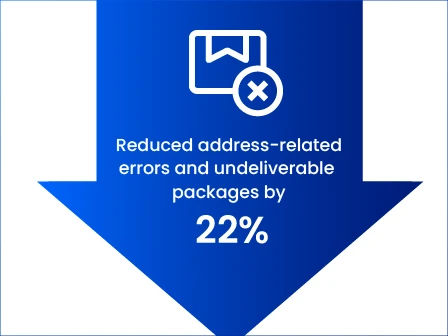How to evaluate the ROI of good address data after implementation
You’ve implemented an address data solution—high five! 🎉 Now comes the big question: How do you compute its value? Evaluating the return on investment (ROI) of good addresses doesn’t stop after setup; that’s where it starts.
Good address data has a host of benefits, from fewer failed deliveries to smoother checkouts and happier customers. Accurate address data quietly powers big wins across your business. 🙌 With the right metrics and tools, you can measure wins and evaluate the ROI of clean, validated address data.
We'll cover:
- The dos and don'ts of calculating address data ROI
- Evaluating delivery success
- Evaluating service call success
- Evaluating conversion rates
- Analyzing data quality and customer satisfaction
- Unlocking the long-term value of address data
- Summing it up—your ROI snapshot
- Need to get your boss on board?
- Conclusion
The dos and don'ts of calculating address data ROI
Evaluating address data ROI can be tricky. Clean, validated address data can have lagging indicators of success, meaning it can take time to observe some of its benefits. This makes it easy to focus exclusively on quick wins or short-term savings, which is a common pitfall in ROI measurement.
One big “don’t” is overlooking the indirect cost savings and non-financial benefits of good address data.
Sure, clean data helps you avoid undeliverable packages and customer complaints (which is awesome), but it also supports smoother operations, better decision-making, and improved customer experience—benefits that might not show up in a spreadsheet right away.
When those indirect issues pile up, they get expensive—fast. In fact, bad address data has a big price tag.
According to the USPS, 5.6 billion pieces of undeliverable-as-addressed (UAA) mail are processed annually, costing businesses over $20 billion each year in wasted postage, operational inefficiencies, upset customers, and lost opportunities. Yikes. 🙈
On the flip side, companies that invest in best-in-class address data see major payoffs. For example, Porch Group Media found that 90% of business leaders see improved customer experiences, and 91% report improved business growth after investing.
So, how can you properly assess ROI when the payoff isn’t apparent or instant? Start with applicable, specific key performance indicators (KPIs). Unlike ROI metrics, which measure overall financial impact, KPIs track specific measurable results that help predict future success.
When selecting KPIs, consider both direct and indirect impacts. Direct KPIs might include things like shipping cost reduction or checkout completion rates. Indirect KPIs could include decreased cart abandonment, improved delivery times, and higher customer satisfaction scores. You need both to get a full picture.
Ready to gauge your current ROI calculating practices? Scroll on! We’ve put together a checklist of dos and don'ts.
| Dos | Don'ts |
|---|---|
| ✅ Keep an eye out for lagging indicators of ROI | ❌ Focus exclusively on quick ROI wins and short-term savings |
| ✅ Consider the indirect impacts of good address data, like smoother operations, better decision-making, and improved customer experience | ❌ Overlook the non-financial benefits of clean address data |
| ✅ Utilize accurate addresses to prevent UAA mail, saving money on postage, operational processes, and customer service calls | ❌ Let bad address data enable costly undeliverable mail to pile up |
| ✅ Measure ROI and predict future successes with specific and applicable KPIs | ❌ Measure ROI with metrics that only calculate the overall financial impact of address data |
| ✅ Make use of KPIs that evaluate the direct and indirect impacts of address data | ❌ Prioritize KPIs that focus on address data’s direct impact on ROI |
Evaluating delivery success
Not sure what KPIs are most important to you? We’ve got you. Let’s take a closer look at some of the top metrics for evaluating address data ROI and how to track them after implementing Smarty.
Delivery success rate

There are several KPIs that can help you measure the financial benefits of using the tools Smarty offers to increase routing success—whether you’re sending packages to customers, refunds to patients, or even technicians to residences.
Delivery success rate is one of the most common metrics for calculating the ROI of address data. After implementation, you can dig deeper with KPIs like on-time delivery rate (OTD) or first-time delivery success (FTDS) rate to gauge how often things are showing up where they should, and what it means for your bottom line.
Missed deliveries aren’t just frustrating for everyone involved—they’re expensive. A failed delivery can cost retailers an average of $17.78 per package, factoring in redelivery, customer service, and product loss. Eek. 😬
To improve its delivery success rate, MAJORITY, a financial service company that frequently sends debit cards to customers, put US Address Verification and US Address Autocomplete to the test.

With these products integrated into its registration process, MAJORITY improved the accuracy of its address data. Clean address data drastically decreased undeliverable mail by 50–70% and lowered the undeliverable debit card rate from 10% to 3–5%. This not only saved their company some serious money but also helped reduce customer frustration.
Redelivery and labor costs
Additionally, redelivery and labor costs are key factors when assessing the ROI of address data. When you have clean address data from the beginning, deliveries become more successful more often, lowering the cost spent on labor and shipping per delivery. Not to mention fewer re-attempts, less wasted fuel, and lower last-mile costs.
Last-mile delivery can account for up to 53% of total shipping costs, and address issues are a leading reason for delays and reroutes. Every avoided redelivery is money in your pocket. To see the full extent of these benefits, analyze how often mail is redelivered due to address errors before and after implementing Smarty’s address verification, autocomplete, and geocoding.
Returned mail and LTV
The frequency of returned mailings is another sneaky expense that can be used as a KPI. When a delivery is made on time the first time, a customer is much more likely to develop trust and make another purchase. So, along with that, accurate address data helps boost lifetime value (LTV) and customer retention, even though that doesn’t always show up in a shipping report.
Deliverability
Measuring undeliverable mail rate is another solid KPI, and that’s exactly how Shippo, a shipping platform focused on modern ecommerce, measures ROI for its address data.
Shippo uses Smarty's US Address Verification to ensure addresses are correct before shipping and has reduced address-related errors and undeliverable packages by 22%. Another added perk is that they now have fewer redelivery costs, higher customer satisfaction, and less strain on their support teams.

Billing accuracy
Healthcare and other providers rely on accurate address data to ensure billing statements and payment reminders are delivered successfully. This makes billing accuracy a key KPI for these companies.
A slew of expenses come with bills that fail to reach their intended destination. Each invoice can cost up to $9 to redeliver. While they’re being shipped (again), payments get delayed. This leads to overdue accounts, which your staff will have to spend additional time managing, leaving you to pay an added $25 per hour.
Delayed payments can also lead a provider to waste massive sums of money relying on credit lines. Uncollectible payments can cause even more damage, as bad debt costs healthcare companies 2% to 5% of their net patient revenue. Ouch!
With accurate address data, bills promptly arrive at the correct address. This leads to timely payments, preventing you from making costly errors. Comparing billing accuracy and collections before and after implementing address validation can demonstrate the substantial ROI that comes from successful deliveries.
Calculate your mail and shipping ROI
Ready to see the ROI of your mailing and shipping practices?
With this tool, you’ll be able to estimate how much you’re currently saving, as well as how much you could save with better address deliverability. Go ahead, give it a whirl!
Estimate your savings & ROI
Evaluating service call success
The term truck roll refers to any situation in which a technician is sent to a different site to help a customer. For companies that dispatch technicians to provide a specific service—equipment installation, maintenance check, etc.—measuring the success rate of truck rolls is vital to calculating the ROI of address data.
Truck roll success rate
A truck roll fails when a technician is sent to the wrong address, or never takes off in the first place. Unfortunately, this is a costly mistake, as a single truck roll can cost anywhere from $200 to $300, and it happens more often than it should.
Evaluating your truck roll's fail and success rates is the first step towards minimizing costs and maximizing win rate.
Address verification will reduce truck roll failures by ensuring the accuracy of your address data. Verified addresses will also send technicians to the correct location the first time, saving you money and keeping your customers happy.
Compare how often your technicians’ truck rolls are successful before and after implementing our address data tools to see how much you’re saving by limiting failed truck rolls.
To fully gauge the success of a truck roll, there are several additional factors to consider, meaning there are several KPIs that will help you calculate the financial advantages of utilizing good address data. We’ll cover the top three.
Customer churn
When technicians are given an inaccurate address, they don’t reach their destination.
Often, these errors cause appointments to be rescheduled, or even worse, cancelled. Customers forced to wait around for a technician—who may or may not be coming—are likely to find a new provider.
Address autocomplete and verification ensure technicians reach the right address to prevent this from happening. Retaining customers can have a huge impact on ROI. On average, address data tools can reduce customer churn by 15%, leading to an estimated $18,000 in total savings. 🤑 Don’t let these wins go unnoticed!
Support calls

Address-related support tickets can also be used to calculate the ROI of address data. When addresses are verified before a technician is sent on a truck roll, customers won’t need to call in to ask where their tech is.
With fewer support calls about addresses, support teams will be able to spend less time redirecting technicians and more time addressing (get it? 😉) customers’ real problems. You might also keep your customer service reps a little longer because they won’t burn out as quickly with fewer complaint calls. Make sure to measure this KPI to see the full extent of these benefits.
Increased efficiency
Reducing customer churn, support calls, and failed truck rolls makes companies more efficient at what they do best.
Verified addresses ensure technicians arrive on time the first time. With all that newfound time, technicians can reach more satisfied customers rather than circling neighborhoods.
Better operational efficiency will increase the number of dispatches your technicians can be sent on each month. This makes calculating your overall number of truckrolls before and after implementation is another solid KPI.
Calculate your service call ROI
Do you want to see the ROI of accurate address data in real time? You could crunch the numbers by hand, or you could use the calculator below. Check it out!
Average of 50-200
Ranges from $250- $1000
20-30% of truck rolls fail due to inaccurate addresses
Evaluating conversion rates
For companies that rely on ecommerce, calculating conversion rates serves as an essential KPI for evaluating the ROI of address data.
To improve their conversion rates, Fabletics used Smarty’s Address Autocomplete to give their customers the quickest checkout experience possible.
While customers complete a checkout form, autocomplete reduces 80% of the keystrokes customers typically use to type out an address. After 1 keystroke, addresses appear in a drop-down list, leading to faster form completion.
With less time to second-guess their purchase, customers are less likely to abandon their cart. For 70% of carts, friction during checkout leads to abandonment, leading to $4.6 trillion lost in ecommerce sales every year. 😰
To avoid adding to these stats, Fabletics optimized their checkout page with autocomplete. This significantly increased their order conversion for new customers around the globe. For example, Canada and Spain's conversion rate went up over 8%! 👏
Don’t let the ROI of address data tools like autocomplete go unnoticed. Compare your conversion rate before and after implementation to see the benefits firsthand.
By evaluating the ROI of clean address data with specific metrics, like delivery success rate, service call performance, and conversion percentage, you can break through the fog of fuzzy ROI calculations and see the real impact of tools like US Address Verification and US Address Autocomplete. Not only do they save money, but they also elevate the entire customer experience.
Analyzing data quality and customer satisfaction
One of the clearest ways to measure the ROI of address data is by looking at data quality. With clean address data, companies can score big by improving data governance, deduplicating records, reducing costly delivery errors, complying with federal laws, and much more.
From standardized data to smoother operations
A common approach is to track how many address fields are standardized and formatted correctly before and after implementing a solution like Smarty.
The more standardized your address data is, the cleaner and more reliable it becomes—and that means fewer errors, smoother operations, and happier customers. Plus, cleaner data is much easier for your teams to analyze. You can make smarter moves in scaling business growth, marketing expenditures, and more with clean, verified, and exact address data.
Take DialCare, a company that offers virtual healthcare services, for example. Before integrating Smarty’s US Address Verification and US Address Autocomplete, their address data included incorrect and duplicate addresses, which cluttered and complicated their system.

Duplicate records create added expenses for healthcare companies like DialCare. One duplicate can cost $40-$50, meaning smaller organizations can expect up to $1,000 in losses, and larger companies could lose up to $10 million.
You don’t want to end up a part of that statistic. With verification and autocomplete helping you reduce duplicate and fragmented records in your database, you don’t have to be.
For DialCare, Smarty’s address data tools made their data significantly cleaner. Their interface also became more user-friendly, leading to better customer experiences and fewer operational hiccups.
Cutting costs with clean data
Accurate data doesn’t just keep things tidy, it actively protects your bottom line. According to a study by Statista, businesses waste up to $20 billion annually due to poor mail management. Reducing address and delivery errors can dramatically reduce waste. Calculating the amount of fraudulent or incorrect address data that’s corrected by address verification can also demonstrate ROI.
Like DialCare, Curatus, a healthcare technology company, found duplicate records in their address data. In one case, a single provider was listed 333 times. 😱
Using Smarty’s US Geocoding, Curatus improved their address data accuracy and streamline its systems. This resulted in fewer duplicate records—and fewer complaints from healthcare providers and customers—plus confidence that its data was in compliance with federal laws (hello, HIPAA peace of mind).
When you improve data quality, you're not just fixing typos—you’re improving delivery rates, reducing fraud, saving money, and building trust.
These are just some of the financial and organizational benefits that come with quality address data. Don’t let these go undiscovered; use the right metrics to better understand how implementing Smarty is impacting you.
Unlocking the long-term value of address data

Remember how we mentioned that clean address data can have lagging indicators of success? Here’s where the long game pays off. Accurate address data now means better machine learning models, stronger decision-making, and more trust in your data later.
Machine learning models are only as smart as the data you feed them. They perform better when you use better data, so cleaning your address data through address verification will lead to better analytics, more reliable predictions, and more meaningful insights.
But clean address data isn’t only beneficial for machine learning; it can also help with human decision-making. When you or your team don’t question whether your data is accurate, you can confidently make fast decisions about everything from logistics to customer service to marketing.
Establishing a reputation for high-quality verified address data can also build trust between a company and its customers or stakeholders. Clean data shows that accuracy, reliability, and getting it right the first time are important to a company, which fosters long-term relationships with external relations.
When it comes to marketing, clean address data opens the door to smarter segmentation and targeting. You can localize campaigns, personalize content based on geography, and ensure offers are actually relevant to where your customers live.
Companies using location-based data in marketing see an average 20% increase in campaign effectiveness.
Clean address data doesn’t just fix failed deliveries—it powers better analytics, faster decisions, stronger brand trust, and more effective marketing.
Summing it up—your ROI snapshot
You’ve run the numbers, crunched the KPIs, and now, it’s time to show the impact.
There are hundreds of ways to determine ROI, so it’s easy to feel overwhelmed. Here are a few examples to spark some ideas and help you spot how good address data is driving value in your business.
With this template, you’ll highlight your business’s real-world gains in no time.
Sample metric summary
| Metric | Before Smarty | After Smarty | Benefit |
|---|---|---|---|
| Delivery success rate | 87% | 97% | Fewer failed shipments |
| Undeliverable mail rate | 10% | 3-5% | Reduced postage + resends |
| Redelivery rate | 12% | 5% | Lower labor + fuel costs |
| Cart abandonment | 69% | 55% | Increased conversions |
| Address-related customer support tickets | High | Significantly lower | Improved customer satisfaction score |
| Failed truck roll rate | 20% | 5% | Lower labor + fuel costs |
| Duplicate records | 10k | 0 | Lower operational costs and streamlined internal efficiency |
| Collections rate | 91% | 93% | Increased revenue |
| Compliance infractions | 2 | 0 | Eliminated unnecessary legal battles and fines |
Need to get your boss on board?
Just share the ROI and savings data from either of the calculators above. Need even more data? Add your customized metric summary. It doesn’t have to be complicated. In fact, you could keep it as simple as sending an email that goes something like this:
“We’ve reduced our undeliverable mail by over 60% since implementing improved address data. It’s saving us thousands monthly in redelivery, customer service, and postage. Renewing keeps our address data clean, protects our customer experience, and helps us avoid future operational costs from dirty data.”
Conclusion
You’ve already made the move to Smarty—and clean, reliable address data. Perhaps you’re discovering that investing in clean address data is one of the highest ROI moves you can make.
But we’re not just a tool for driving obvious address data ROI, we’re here to help you improve your day-to-day operations and better your customers’ experience.
Evaluating the ROI of good address data makes its benefits clear. Luckily, you don’t need to calculate every ROI we’ve covered to see it, but if you do, you’ll see mind-blowing results. Don’t let those wins stay tucked away; find the KPIs that will help you tell your success story.
Already have a success story? Share it with us! You could reach out to your account executive or customer success manager, or even post about your breakthrough on social media and tag us.
Nothing makes us happier than celebrating customer wins (and maybe bragging about you a little bit, too 😄).
